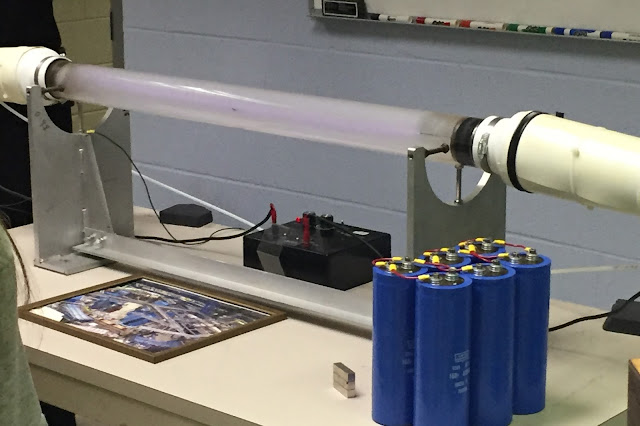A couple of weeks ago, I took Mason on a field trip to the LSU Center for Advanced Microstructures and Devices (CAMD). Yes. I know.
I didn't do my research prior to this field trip. I'd never even heard of this place before. The title alone . . . well, it made me want to run away. Far away. I'm not a science kind of girl. My brain just doesn't think that way at all. As a matter of fact, science stuff just blows my mind. To bits and pieces. My nephew Beau is all into robotics. He makes all kinds of fancy gadgets and even programs them with his computer. He has quite a fancy set-up in his room, including a router (I think that's what it's called). Not too long ago, I saw him doing some "programming" on his computer. I asked him to show me what he was doing and was basically all "how in the world did you figure this out?!" He tried. He really did. But I still have no idea! I gave him a couple of programming books last Christmas. I opened them to read a few pages. After the first sentence, I promptly closed the book and wrapped them up. I just don't get it. I took chemistry in high school but only because I had to. That class intimidated me to no end. I took two years of biology, which was much more manageable As long as I didn't have to dissect anything. I refused to take physics. Refused. Wouldn't even walk by the door. When I got to college, I made sure my major required only the very bare minimum in science classes, and I promptly took all my classes and labs during my freshman year so they could be done. Of course, I took biology. Not chemistry. Not physics.
So here we are at CAMD. I mean, obviously I knew that it was a place for scientific research and such. Scientists from all over the world come here for their research. There are only seven of these in the nation. I knew most of the research deal with energy, the environment and medicine/radiation. But that's it. I figured I'd just wing it and learn along with everyone else at the field trip. But when we walked in for our first presentation, and I saw this, I knew I was in over my head. WAY OVER MY HEAD.
So, in CAMD-for-dummies terms, it's basically an electron race track. Yep. A race track for electrons. The track is in the shape of a ring, and there are seven or eight stations (if you will) around the ring where research takes place, all with a different focus. And that's about the best way I can explain it.
So, anyway, here we are in this room with a physicist who is explaining to us how the electron ring works and why. Have I mentioned I deliberately did not take a single physics class?! I was reminded two weeks ago why! Really though, the guy did a great job. He basically created a lightening bolt in this tube and then went from there. But please don't ask me to explain that in light of the electron ring and the color spectrum (including the colors you can't see). Because I can't.
And then we got to see the electron ring itself. Here's one side of it. Again. Blows my mind! And, yes. I wondered more than once if we might just all blow up in there!
We then visited three of the research stations. One of them had to do with radiation, x-ray technology and CT scans. This particular scientist was actually employed by LSU and was doing research for one of their classes. And that's all I can tell you about that. The second station had to do with vacuums. But please don't ask me how that relates to electrons. I don't remember. I don't remember the point of the third station, but we got to look at our hair and our clothing through this huge, fancy microscope. It was fascinating. Truly. But you know what I'm thinking? Let's just say one of the scientists addressed the issue of cost. Their second largest expense (salaries, of course, being number one) is electricity. The electric bill averages $400,000 annually. Yes. Now that is my language. That would be why I was a business major!
This field trip was great. It really was. And I'd love to go back. But our favorite part was definitely the end. One of the scientists played with liquid nitrogen. He explained what it is and what it does and what it can be used for. He gave each student a bunch of parsley and let them dip it in a bowl of the liquid nitrogen. It froze, of course, in a matter of seconds. Mason thought that was super cool.
And then they made ice cream. With liquid nitrogen. They began by mixing a 2-liter bottle of orange crush and a can of condensed milk in a bowl.
And then they added the liquid nitrogen.And they stirred a whole lot.
And everyone got a cup of orange ice cream! Mason liked it. It was interesting. Yes. Interesting. The taste, I mean.
On the way home, Mason asked me if we could buy some liquid nitrogen. No. No, we cannot.











